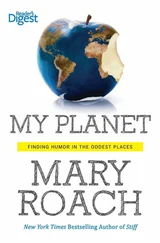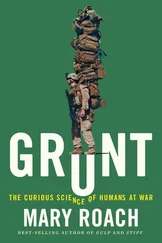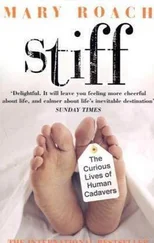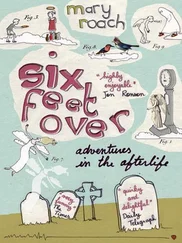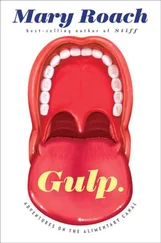I RECALL AN IMAGE from early this morning. Two of Bolte’s students, Hannah and Mike, are standing beside F, talking and laughing as they untangle the long, fine wires that trail from the strain gauges mounted on F’s bones. Rather than seeming gruesome, the scene had a comfortable, familial feel, like a family stringing lights on the Christmas tree. I was struck by how at ease the students were. To them, the cadaver seemed to inhabit an in-between category of existence: less than a person, but more than a piece of tissue. F was still a “he,” but not someone you needed to worry about hurting. Hannah, in particular, had a lovely way with him. While F lay in the CT scanner late that night, an automated recording commanded, “Hold your breath.” “He’s really good at that,” she said. It was funny, but also a sideways acknowledgment of the unusual talents and abilities of the dead.
Not quite so at ease were the NASA team. Outside the context of the testing (and the carpool lane bit), they made very few references to him, and usually with the pronoun it . Getting permission to be here entailed months of emailing with a NASA public affairs officer and culminated in a flurry of tense phone calls upon my arrival this morning. Dead people make NASA uncomfortable. They don’t use the word cadaver in their documents and publications, preferring the new euphemism postmortem human subject (or, yet more cagily, PMHS). In part, I’m guessing, it’s because of the associations. Corpses in spaceships take them to places they’d rather not revisit: Challenger, Columbia, the Apollo 1 fire. And partly, they are unaccustomed to it. I have come across only one project that made use of human cadavers in the past twenty-five years of aeromedical research. In 1990, a human skull rode Space Shuttle Atlantis, kitted out with dosimeters, to help researchers determine how much radiation penetrates astronauts’ heads in low Earth orbit. Worried that the astronauts would be unnerved by their decapitated crewmate, the researchers covered the bone with pinkish plastic molded to approximate a face. “The result was far more menacing than plain bone would have been,” noted astronaut Mike Mullane. [40] Here’s another possible reason NASA avoids cadaver research: astronauts. “I floated into a sleep restraint and extended my arms through the armholes then ducked my head into the bag,” wrote Mullane. “Pepe and Dave taped the skull on top…They silently floated the bag to the flight deck and maneuvered me behind John Casper, who was engaged at an instrument panel. When he turned to find the creature in his face with arms waving, it scared the bejesus out of him. Later, we clamped [it] on the toilet.” If you read just one astronaut memoir in your life, make it Mullane’s.
Back in the Apollo era, the agency’s discomfort over using dead people in capsule impact studies appeared to transcend any discomfort they felt about using live ones. In 1965, NASA collaborated with the Air Force on a series of tests very similar to today’s—but with human volunteers. Personnel from Holloman Air Force Base, seventy-nine in all, rode an ersatz Apollo space capsule seat on an impact sled while wearing helmets and other spacesuit components. The men endured 288 simulated splash-downs: upside down and right side up, backward, forward, sideways, at 45-degree angles. Peak forces were as high as 36 G’s, more than twice as powerful as the 12 to 15 G’s inflicted on Subject F today.
Colonel John Paul Stapp, a pioneer in human impact tolerance research, breezily summed up the project in a press release: “It might be said that at the cost of a few stiff necks, kinked backs, bruised elbows, and occasional profanity, the Apollo capsule has been made safe for the three astronauts who will have perils enough left over in the unknown hazards of the first flight to the moon.”
I spoke to a man who rode Holloman’s Daisy sled six times, in various positions, while wearing an Apollo helmet. Earl Cline is sixty-six now. His last ride was in 1966—25 G’s. I asked Cline whether he’d suffered any lasting damage. He replied that he hadn’t had any problems, but as the conversation went on, things began to emerge. To this day, he has pain in the shoulder that bore the brunt of a lateral impact. At the time of his discharge, he was found to have a torn heart valve and one eye that’s “off a little bit.”
Cline reserves his sympathy for the guy whose eardrum ruptured and the one who rode the Apollo seat upside down “with his rear end up in the air” and wound up with a ruptured stomach.
Cline expressed neither resentment nor regret, and has not pursued a disability claim. “I am very proud of the fact that I contributed. I like to think that when they went up in the Apollo missions their helmets didn’t shatter or anything because I tested them.” A subject named Tourville expressed a similar sentiment in a newspaper interview at the time of the Stapp “a few stiff necks” press release: “As long as I know this will save our Apollo astronauts from being hurt on their landings I don’t mind losing sleep with a stiff back for a few days.” Tourville took 25 G’s and suffered a compression injury of the soft tissue surrounding three vertebrae.
Added motivation was provided by a generous hazardous-duty stipend. Bill Britz, a Holloman Air Force Base veterinarian, recalls being paid an extra $100 a month. Cline received $60 to $65 a month for riding the sleds a maximum of three times a week. Given that his base pay was $72 at that time, it was a significant amount. “I lived like an officer,” Cline told me, adding that there was a waiting list to become a Daisy sled volunteer. This was not the case over at Stanley Aviation, in Denver, which NASA had contracted to do some landing impact studies. Capsule mock-ups were hoisted aloft and then dropped onto surfaces of differing compressibility to see what sorts of injuries an astronaut might have to cope with should the capsule go off course and land not on water, but on dirt or gravel or the Winn-Dixie parking lot. There, Britz told me, the pay was only $25. “They got derelicts from Skid Row!” You would think that a news scandal involving underpaid indigents would be a scarier prospect for NASA than one involving cadavers, but things were different back then. The homeless were “derelicts” and “bums,” and cadavers were people who rest on satin pillows.
THE FIRST AMERICAN to live through a space capsule landing mishap endured 3 G’s more than the mission planners had anticipated. His capsule arced 42 miles higher than it was meant to and landed 442 miles off course. By the time rescue ships reached it, two and a half hours later, it had taken on 800 pounds of water and was partly submerged. With great trepidation, the hatch was opened. The space traveler was alive! Upon returning to base, he leapt into the waiting arms of Air Force Master Sergeant Ed Dittmer.
The astronaut was the three-year-old chimpanzee called Ham. (Dittmer was Ham’s trainer.) Ham was more than just the first space capsule landing mishap, of course. He was the first American to ride a capsule into space and come back down alive. As such, he put a bit of a tarnish on the Mercury astronauts’ considerable shine. Ham’s much-publicized flight made it clear to all: The astronaut doesn’t fly the capsule; the capsule flies the astronaut. Along with fellow astrochimp Enos, who orbited Earth three months before John Glenn, Ham was the embodiment of a debate that persists to this day: Are astronauts necessary?
8. ONE FURRY STEP FOR MANKIND
The Strange Careers of Ham and Enos

The John P. Stapp Air and Space Park is made entirely of things that can hurt you. Eleven historical missiles are displayed amid plantings of spiny desert succulents. You walk along the gravel pathways, reading the little signs: PRICKLY PEAR, LITTLE JOE, CRIMSON HEDGEHOG. From the names alone, it is sometimes hard to know which is which. Is TURKS HEAD a cactus or an exploding munition? A similar sort of confusion can be found 25 yards down the hill, at the base of the flagpoles that mark the entrance to the park and the adjoining New Mexico Museum of Space History and International Space Hall of Fame. Flush to the pavement is a bronze grave marker that says, WORLD’S FIRST ASTROCHIMP HAM. [41] A comma would have been good. “Astrochimp Ham” is perilously suggestive of a cut of meat made from a dead research animal. It wouldn’t be a first. In a stunning public relations lapse known as Project Barbecue, pigs who died on Air Force crash sleds in a 1952 test of seatbelt safety were served in the mess hall later that night.
The astrochimps were a knotty chimera. People weren’t sure how to think of them. Chimps or astronauts? Research animals or national heroes? They’re still not. Someone has left a basket of flowers on the grave, and someone else has left a plastic banana.
Читать дальше


